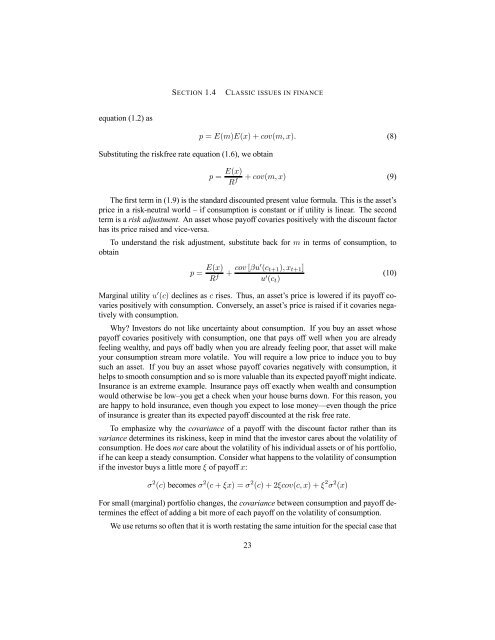Asset Pricing John H. Cochrane June 12, 2000
Asset Pricing John H. Cochrane June 12, 2000
Asset Pricing John H. Cochrane June 12, 2000
Create successful ePaper yourself
Turn your PDF publications into a flip-book with our unique Google optimized e-Paper software.
equation (1.2) as<br />
SECTION 1.4 CLASSIC ISSUES IN FINANCE<br />
Substituting the riskfree rate equation (1.6), we obtain<br />
p = E(m)E(x)+cov(m, x). (8)<br />
p = E(x)<br />
+ cov(m, x) (9)<br />
Rf The first term in (1.9) is the standard discounted present value formula. This is the asset’s<br />
price in a risk-neutral world – if consumption is constant or if utility is linear. The second<br />
term is a risk adjustment. An asset whose payoff covaries positively with the discount factor<br />
has its price raised and vice-versa.<br />
To understand the risk adjustment, substitute back for m in terms of consumption, to<br />
obtain<br />
p = E(x)<br />
Rf + cov [βu0 (ct+1),xt+1]<br />
u0 (10)<br />
(ct)<br />
Marginal utility u0 (c) declines as c rises. Thus, an asset’s price is lowered if its payoff covaries<br />
positively with consumption. Conversely, an asset’s price is raised if it covaries negatively<br />
with consumption.<br />
Why? Investors do not like uncertainty about consumption. If you buy an asset whose<br />
payoff covaries positively with consumption, one that pays off well when you are already<br />
feeling wealthy, and pays off badly when you are already feeling poor, that asset will make<br />
your consumption stream more volatile. You will require a low price to induce you to buy<br />
such an asset. If you buy an asset whose payoff covaries negatively with consumption, it<br />
helps to smooth consumption and so is more valuable than its expected payoff might indicate.<br />
Insurance is an extreme example. Insurance pays off exactly when wealth and consumption<br />
would otherwise be low–you get a check when your house burns down. For this reason, you<br />
are happy to hold insurance, even though you expect to lose money—even though the price<br />
of insurance is greater than its expected payoff discounted at the risk free rate.<br />
To emphasize why the covariance of a payoff with the discount factor rather than its<br />
variance determines its riskiness, keep in mind that the investor cares about the volatility of<br />
consumption. He does not care about the volatility of his individual assets or of his portfolio,<br />
if he can keep a steady consumption. Consider what happens to the volatility of consumption<br />
if the investor buys a little more ξ of payoff x:<br />
σ 2 (c) becomes σ 2 (c + ξx) =σ 2 (c)+2ξcov(c, x)+ξ 2 σ 2 (x)<br />
For small (marginal) portfolio changes, the covariance between consumption and payoff determines<br />
the effect of adding a bit more of each payoff on the volatility of consumption.<br />
We use returns so often that it is worth restating the same intuition for the special case that<br />
23
















